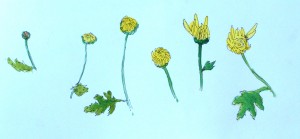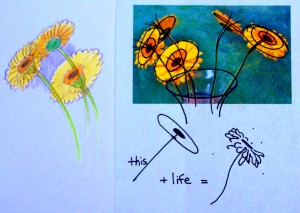Last week, in Exercise on How to Draw a Flower, we thought about ellipses. This week we’ll get a feel for connecting the stem to the ellipse / blossom.

Chrysanthemum buds opening - If you buy a potted plant, you can see all the stages at once. I bought one at the supermarket today and broke off a few buds to study.
As a flower pushes up from the ground, its stem become longer, stronger, and wider. All the food and drink it needs is carried through this growing stem. If all goes well, the tiny bud that begins to show at its tip will enlarge and open bit by bit revealing the mature flower in all its glory.
All that dynamism can be (over) simplified with the concept of a stick stuck to the middle of an ellipse.
If you get that part right, you will have a believable flower. And once you get that part, you can make each flower unique and expressive.
It helps to draw the areas that you can’t see (note the diagram above). Work as if the flower was transparent. If you draw the stem right up through the middle of the blossom, you are more likely to connect the two the right way. You can always erase those lines later. Completing the movement of a line by drawing as if things were transparent while you position them will create a strong sense of form, and both you and your viewers will be able to feel the life force that moves up and through the plant.
Assignment:
1. Watch the video below (made by Vladimir Vorobyov from Astana city, Kazakhstan).
2. Draw Gerber daisies (can’t miss their ellipses!).




